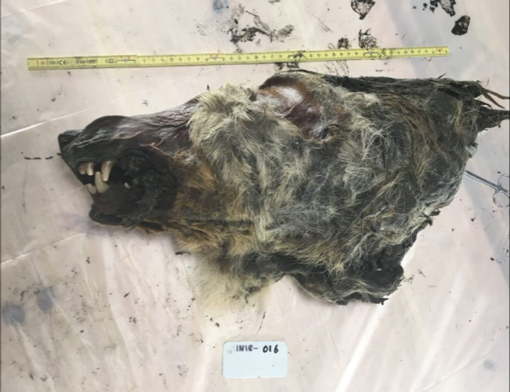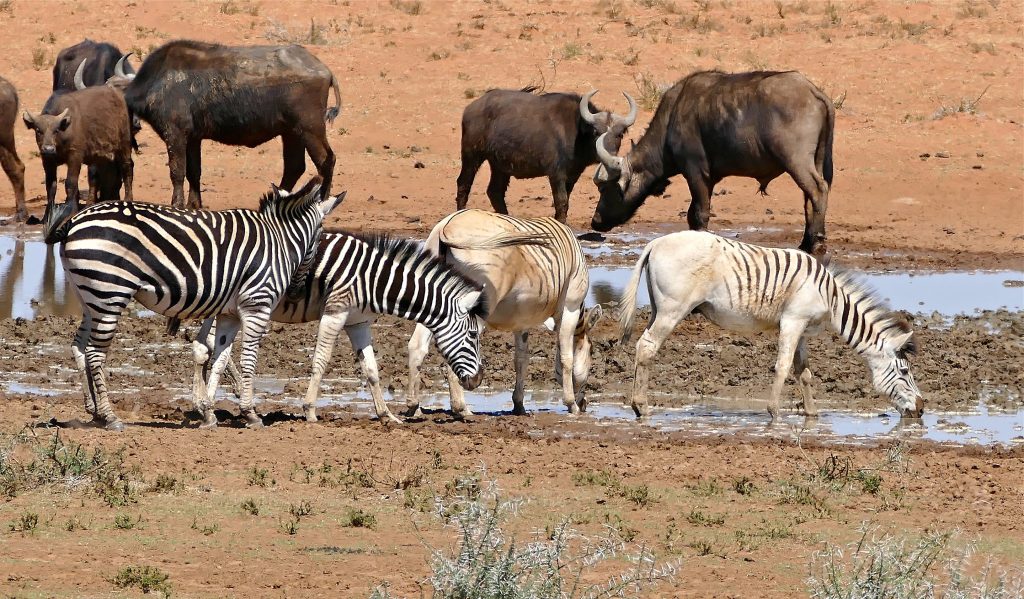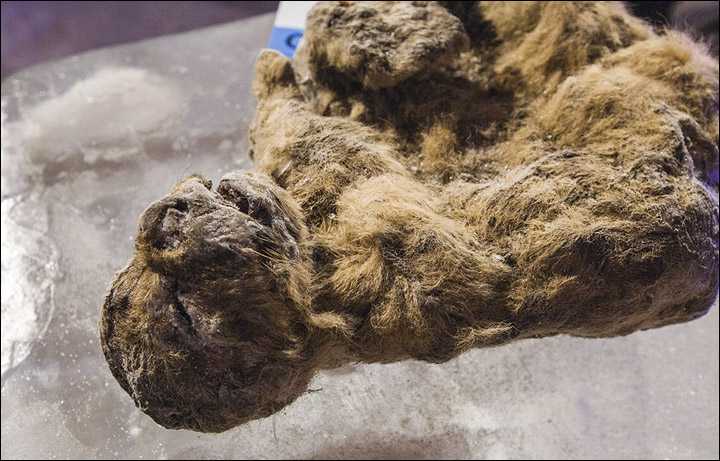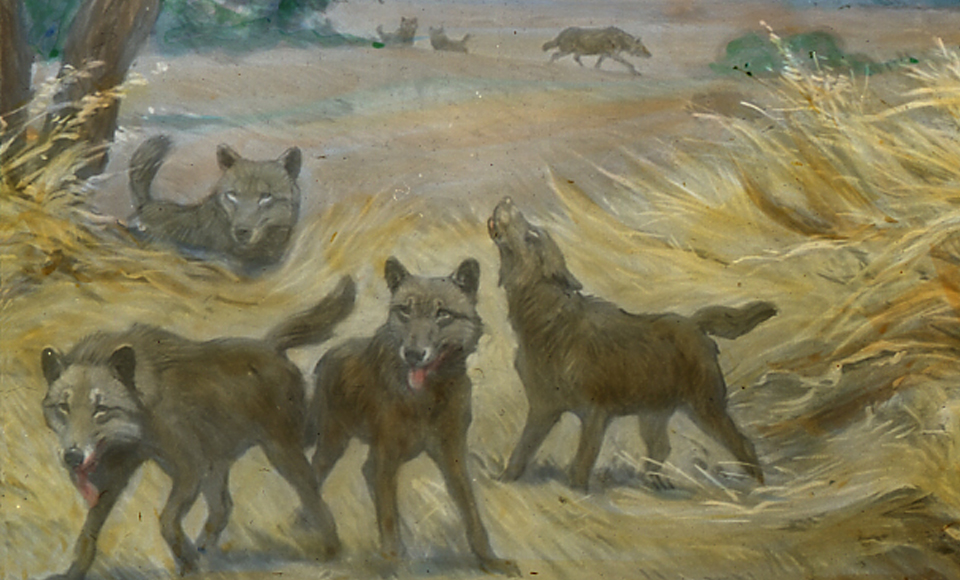Can I Have a Direwolf?
Dirty Science by Dr Brenna HassettIt’s all Jurassic Park’s fault. New discoveries in Siberia have got people asking, can I have a pet direwolf now?
Once again, the spectre of recreating a world last seen tens of thousands of years ago has reared its (slightly mouldering) head. This time, it’s news of the discovery in Siberia of a 40,000 year old wolf’s head, found lodged in the Siberian permafrost by a team[i] from the Academy of Sciences of Sakha, that begs the question: what can we do with the frozen menagerie slowly emerging from the permafrost?

The amazingly well-preserved head of a Pleistocene wolf from the Yakutia region of Siberia. Photo courtesy of Dr Tori Herridge.
The Science of Pleistocene Pets
It’s not inconceivable that scientists, someday soon, will be able to actually reconstruct extinct species. There are a couple of key factors that have taken us from science-fiction resurrections to funded-science resurrections: improvements in DNA sequencing technology that lets us fill in the blanks and ‘read’ whole genomes from scrappier remains, and advances in reproductive technology that let us edit or even replace genetic code before an animal is born.
First, the technology. It’s actually quite hard to de-extinct something. You could try breeding a bunch of animals that might have Pleistocene traits back together until your elephants start getting furry, but that doesn’t seem to be a terribly successful strategy; decades down the line and everyone’s still a few stripes short of a Quagga.

Regular zebras hanging out with Quaggas
Though to be fair, you wouldn’t want to mess with Heck cattle any more than you’d want to pester aurochs. It’s just not viable long-term. We tend to be much better at domestication – give us a fox and forty generations, and we’ll give you… well, we’ll give you a fox. But it will like you and have floppy ears.[ii]
But breeding down through the generations for specific traits is technology we’ve been employing for thousands and thousands of years. More recently, we’ve even taken up cloning, which has resulted in approximately one sheep and a tonne of very expensive schemes to reproduce Fluffy the Wonderpoodle unto the nth generation. However, you need somatic cells for cloning to work, and that’s not going to happen without a live (or pretty recently alive) donor.
But we have a new trick! Via increasingly sophisticated DNA sequencing technologies (both computational and extractive parts), it’s possible to identify chunks of DNA that overlap, and from these, build up the entirety of an extinct animal’s DNA sequence. The alphabet-soup lines of DNA code are preserved in scraps and wisps, meaning we really do have to strike it lucky to get enough to reconstruct the whole genome. This is one of the reasons why Siberia is so popular with the de-extinction set – the cold, dry conditions are ideal for preserving the collagen and other organic residues that hold DNA. We can take that extinct DNA sequence and edit it right back into something else’s DNA, until we have the genetic equivalent of a ransom letter cut out of words from different magazines. Then we’re right back to trying to get it born – and there are all sorts of difficulties along the way. The techniques we have used for cloning should come in handy though.
The Cosmic Shambles Network relies on your support on pledges via Patreon so we can continue to provide great, new, exciting content without the need for third party ads or paywalls.
For as little as $1 a month you can support what we do and get some great rewards for doing so as well. Click the Patreon logo to pledge or find out more.
So, I can have my Direwolf, yeah?
For those of us who took the lesson of Jurassic Park to heart,[iii] the idea of scientists bringing back megafauna we haven’t seen for 10,000 years is worrying, to say the least. In 2015, enough chunks of mammoth DNA were recovered to finally sequence the entire mammoth genome, prompting a sudden flurry of interest in reintroducing a furry four-legged leviathan to a world that can’t manage to keep Dumbo from going extinct. While the scientific community at large raised its voice to point out that it might be a bit mean to reintroduce an animal dressed for an ice age into the fiery end of the Anthropocene, that doesn’t seem to have stopped others from pressing ahead with a cloning project.
The ethical minefield doesn’t end with mammoths, however, and as more and more well-preserved cast members of Game of Thrones are pulled from the ice, it’s worth considering what we can do with baby lion cubs, an extinct horse, and the rest of the large fauna[iv] that had the consideration to die in the world’s largest walk-in freezer. Do we recreate them, seeding other animals’ eggs with reconstituted DNA and hope that the result is an authentic Pleistocene critter rather than a zombie hybrid? And more importantly, why would we do it?
There are compelling reasons to haul industrial hair dryers and some damn sturdy shovels into the far north, of course.
For one thing, there is only so much about the animal life of the past we can learn from bones alone. Bones you can find anywhere, but the cold and dry conditions of the Siberian tundra offer a unique opportunity to preserve skin, hair, and even blood. A 50,000 year-old lion cub is actually a perfect opportunity to understand how the leopard got its spots. The 42,000 year old blood frozen in the veins of the little foal can tell us how his species relates to the horses that no longer roam the tundra. The preservation of environmental indicators like botanic remains – like buttercups in mammoth tummies — can give us unprecedented insight into what really is a lost world.

Credit: Vera Salnitskaya/Siberian Times
But should we bring them back? Do we need the genetic diversity locked away in these species to spice up the ones we’re rapidly eradicating from the planet? Currently, even the furthest reaching genomic science has failed to produce a viable Siberian spin-off of Sylvanian families. Maybe we should hold off bringing back the cave lions until we’ve worked out ways to save the ones we’ve got.
So, no. No Direwolf [v] for you. You’re better off, really. And so are your soft furnishings.
[i] Full disclosure – colleague and general awesome person Dr Tori Herridge was part of this team.
[ii] Just like Darwin said – show me an animal with floppy ears, and I’ll show you an animal that’s been messed about by domestication. This may be slightly paraphrased.
[iii] The secondary lesson about bringing dinosaurs back to life, I mean. Not the one about the importance of listening to Jeff Goldblum. That stands.
[iv] Aside from an intensely realistic restaging of Clan of the Cave Bear. Obviously.
[v] Also, technically direwolves are a different North American species, so… no.
Quagga image: Bernard DUPONT
Feature painting by Charles Wright. The Jesse Earl Hyde Collection, Case Western Reserve University (CWRU) Department of Geological Sciences http://geology.cwru.edu/~huwig/
 Dr Brenna Hassett is an archaeologist specialising in the analysis of human remains as a researcher at University College London and a Scientific Associate at the Natural History Museum London. She has dug on sites across the globe, from Greece to Egypt to Thailand and beyond. She is one quarter of The Trowelblazers group. Her first book, Built on Bones, was published in 2017 and she is currently writing her second, due for release in 2021. She is on Twitter at @brennawalks
Dr Brenna Hassett is an archaeologist specialising in the analysis of human remains as a researcher at University College London and a Scientific Associate at the Natural History Museum London. She has dug on sites across the globe, from Greece to Egypt to Thailand and beyond. She is one quarter of The Trowelblazers group. Her first book, Built on Bones, was published in 2017 and she is currently writing her second, due for release in 2021. She is on Twitter at @brennawalks
If you would like to reuse this content please contact us for details
Subscribe to The Cosmic Shambles Network Mailing list here.
The Cosmic Shambles Network relies on your support on pledges via Patreon so we can continue to provide great, new, exciting content without the need for third party ads or paywalls.
For as little as $1 a month you can support what we do and get some great rewards for doing so as well. Click the Patreon logo to pledge or find out more.


